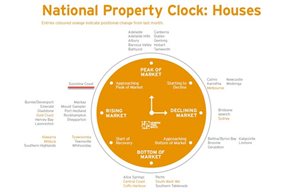Is the Sunshine Coast property market approaching it's peak?
In a report released by Herron Todd White this month, "National Property Clock" which has tipped the Sunshine Coast as approaching the peak of the market.
This is their commentary on the current Sunshine Coast market.
In the early stages of 2020, we experienced the escalation of COVID-19, which in turn led to restrictions on social interaction and ultimately nationwide lockdowns and the closure of the state’s
borders. As a result, there was a high level of uncertainty about the economy and the property market as a whole for a short period.
However, Queensland has been on the forefront of containing the spread of the virus, actively keeping the borders closed to the remainder of the country until 10 July.
As restrictions ease, recorded cases continue to decline and government stimulus packages (JobKeeper and Homebuilder) continue to roll out, it appears there has been a considerable resurgence of confidence in the market. Agents have reported a high level of interest throughout most areas but in particular beachside suburbs which have historically been sought after.
Extremely low stock levels coupled with all-time low interest rates and considerable economic stimulus packages have in most cases seen property values remain stable on the tail end of the pandemic and in some instances value rises have occurred. Moving forward there are some concerns as to how the property market may react once the government stimulus packages are wound back towards the end of the year.
Investors in the Sunshine Coast property market are still active with market sentiment having improved which has in turn instilled confidence in the marketplace. The main driver of this sentiment is the Sunshine Coast lifestyle and the major infrastructure projects across the Coast. With interest rates at an all-time low, investors are looking to property as a way or increasing their returns. Across the Coast, gross yields normally tend to range between four and 15 per cent which reflects the relative risk on investment.
Properties situated within areas underpinned by re-development potential or situated in highly sought-after localities tend to be at the lower end of the yield range. A yield at the higher end of the yield range is typically achieved by units within the main tourist precincts however with high body corporate and management fees, much of these yields can be eroded.
Standard dwellings on the coast typically show a return of four to five per cent which is primarily driven by first time investors. We have seen an increase in interstate investors throughout the Sunshine Coast who have been purchasing and constructing dual occupancy style properties which generally provide a higher yield of up to 6.5 per cent. Slightly higher yields can also be achieved through the hinterland townships with properties comprising three to five flats achieving yields in the seven to eight per cent range. Typically these properties are older with ongoing maintenance and additional management fees required.
In the prestige market we have continued to see a number of investors, however it is difficult to gauge given that there are a number of different drivers in the investment decision. This market is closely related to the southern markets of Sydney, Melbourne and Brisbane. Investors within the segment have typically looked at investing in the Noosa region with a view that their investment may become the future retirement home and principal place of residence.
All in all, the investment market on the Sunshine Coast has been pretty healthy. The good thing is that there are a number of infrastructures projects underway and still in the pipeline that will help with maintaining market sentiment in the area.




